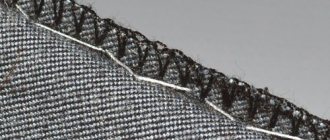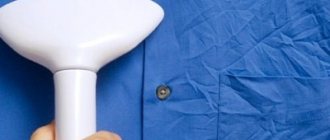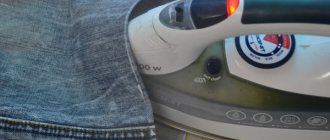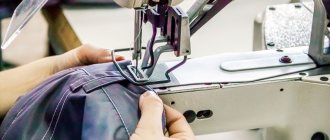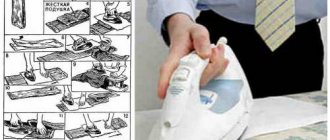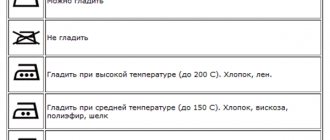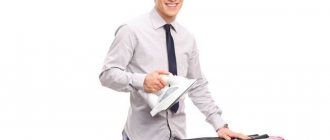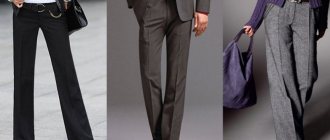The problem of changing pants to a size smaller can arise for various reasons.
Firstly, the new thing may not fit your figure so perfectly. The non-standard figure of girls pushes them to undergo this operation in the pursuit of beauty. For example, height, fatness or thinness. Most often the length is shortened. Secondly, the product may stretch if washed incorrectly. Most often this is non-compliance with the temperature or spin conditions. The length or width of the trouser legs is altered.
Thirdly, my favorite thing became too big after losing weight. You will have to change the width of the trouser legs, at the waist, at the hips. Fourthly, the purchase was made under the influence of a moment of weakness. I liked the model, but didn't have the right size. But upon closer examination, it was decided to sew in or alter the product.
Fifthly, following fashion trends is not always affordable for fashionistas. And you have to resort to tricks. One such change is altering existing trousers. Or just change the model of your pants. Sixth, the trousers can fit well, except in some places. For example, flares, in the hip area.
Seventhly, abrasions or defects of the product could be discovered. Such services can be expensive in a studio. Therefore, it is better to stitch at home, provided you have minimal sewing knowledge.
Causes
There may be several reasons why you have to change the size of an item:
- Firstly, even new trousers may not fit your figure as perfectly as you would like. The problem in this case is complicated by non-standard parameters and proportions.
- Secondly, if washed incorrectly, the fabric can become deformed, and you already get a model that is, as they say, “to grow.” Most often this happens when the temperature or spin mode is not observed. Usually the width and length of the model are subject to correction.
- Thirdly, you may simply lose weight, and your favorite item becomes baggy and uncomfortable. As a rule, in this situation you have to change the width of the trouser legs, as well as reduce the size of the item at the hips and waist.
- Fourthly, the item was purchased obviously not in your size, simply because there was no other size. And now, in order to wear the item you like, you need to change the size yourself.
- Fifthly, the reason for the “reconstruction” is changing fashion: today wide trousers are in trend, and tomorrow – tight ones. In order not to purchase a new item for each season, it makes sense to adjust existing models.
- Sixthly, and this is perhaps one of the most common options, the item fits well, but not in all places. For example, the waist suits you, but the hips are too wide.
- Seventhly, the reason for alterations is the discovery of defects in the fabric or abrasions. In this case, having minimal seamstress skills, you can easily “hide” the defect.
There are many reasons why you may need to sew in your trousers.
Who are they suitable for?
To choose a suitable model, you should focus on the features of your figure. Trousers should emphasize your strengths and hide your flaws. Only in this case will it be possible to look as harmonious as possible.
The most balanced option is considered to be an hourglass figure. In this case, the volume of the chest and hips is the same. Any style will suit these girls. They can afford both tight-fitting skinnies and more traditional straight models that taper at the bottom.
Materials and tools
You will need a gentleman's set of tailor's tools: needles, pins, tailor's yardstick, strong thread, scissors and soap or chalk.
Prepare in advance the tools you may need. A sewing machine is not always required. But minimal sewing skills will not be superfluous. It has been noticed that a professional spends 30-40 minutes on correcting products, while a beginner needs at least 2-3 hours.
A sewing machine will not be needed in all cases. And remember, trousers are considered a complex tailoring product, which means that sewing them will require a lot of effort and patience.
Women's trousers are considered a rather complex sewing product.
We sew by hand
First of all, you need to decide in which direction the product will be corrected. They are sutured either along the length (shortened), or along the width of the trouser legs, or at the hips or waist.
If you need to reduce your trousers not at the waist, you can do without a pattern. In some cases, suturing can be done without a pattern. These are small adjustments, for example, changing the length, creating small darts, narrowing the trouser legs towards the bottom. And in other situations you cannot do without a pattern, usually this concerns changes in the waist area.
To solve such a problem, a pattern is often required.
Product preparation
Don't rush to pick up a needle and thread. To make the process as convenient as possible and the result worthy, the item needs to be prepared.
- The item needs to be washed. Natural fabrics such as cotton, wool, linen shrink and may well fit to the size you need.
- Ironing the thing. This is necessary to avoid mistakes and irregularities.
- The trousers are tried on with pins on the fabric.
Excess fabric is marked with pins. As you prepare, always have chalk or soap ready, as well as a sewing ruler, pins, and scissors.
Keep all the necessary tools at hand.
Do not make marks on the fabric with a pen or pencil. There will be traces left that are difficult to get rid of.
Tips for reducing your jeans size at home
Working on reducing your jeans size yourself will require perseverance and painstaking work. The experience of experienced craftswomen will help.
Tips for sewing jeans:
- Carry out the work on a clean product that has already been worn. This way you will see how much the jeans stretch as you wear them.
- Take your time and don't rush! It is better to do an additional fitting to adjust the pants to your figure than to ruin the item.
- Do not rip the legs of your trousers completely, turning them into a skirt: not everyone can sew them correctly in the crotch area on their own.
- Use double stitching and extra stitches at the end of the seam to improve the quality of your work.
Perform all actions carefully and carefully, and you will succeed!
Boyfriend JeansPush Up Jeans
There were flared trousers, but now they are straight
A flare is an extension of trousers that can start from the waist, hip or knee.
It is possible to convert flares into straight trousers. How to remove this extension?
- Try on the item and carefully examine yourself in the mirror. Evaluate the fit of the item from different angles.
- Sewing pins mark the excess that will need to be removed. We stick the pins with the point down so as not to get hurt.
- You can mark on two legs at once, or you can only mark on one, and then use a ruler to transfer the measurements to the other. Ultimately, both pant legs should be the same.
- We remove the trousers carefully so that the needles do not fall out.
- We lay out the product on a large table, aligning the edges.
- We perform all actions first on one trouser leg, and then on the other.
- We draw a line marked with pins with chalk, then remove the pins and carefully straighten the pant leg.
- Mark the second line for the side seam (approximately 1-2 cm).
- Along the first line we baste and try on the item. We evaluate the convenience, make sure that the seam is straight, and check for errors in the measurements.
- If necessary, we make adjustments and try it on again.
- We remove excess fabric, iron it, finish the edge, and sew it on a sewing machine.
The lower part is neatly tapered.
How to tape your trousers to the bottom
First, we rip out the hem of the trousers and iron the product. We try it on and note how much the trouser leg needs to be narrowed. If the adjustment is small, then we sew it on one side, and if we need to significantly reduce the width, then we sew it on both sides. With a small adjustment, it is recommended to evaluate which side - internal or external - is better to sutured. The peculiarity of the seam and the presence of decor are taken into account.
A common reason for sewing up trousers is the desire to narrow them at the bottom. Mark the excess fabric on the fabric. You should be especially careful with stretch fabrics. If you suture by pulling the fabric, the result will be crooked. If the fabric does not stretch, then you can sew it as wide as possible to such a width that the leg fits comfortably into the pant leg.
Algorithm of actions
- We carefully spread the pants on the table. At the same time, the table must be large enough for the item to fit completely.
- We align, draw a line along the pins, then draw another one for the seam.
- We mark along the first line.
- We try them on and evaluate how beautifully and comfortably the trousers fit.
- If something doesn’t suit you, we adjust it and try it on again.
- Cut off the excess fabric and trim the edge.
- Then we sew a line on a sewing machine.
If everything is done correctly, the result will please you. If you need to narrow it a lot, then all the above actions are carried out both on the outside and on the inside of the trouser leg.
Is it possible to seat a certain area
It is very difficult for those with a non-standard figure to choose jeans with an ideal fit. The method of shrinking in certain areas (waist, hips, knees) will help solve the problem.
The following manipulations will help you reduce jeans to the required size in the desired area and adjust the cut to your figure:
- dilute fabric softener with water. Place the resulting mixture in a spray bottle;
- carefully spray the resulting mixture onto the part of the trousers that requires correction;
- place the jeans in the washing machine and turn on the washing mode at the maximum degree (95 C);
- Gins must be dried in a dryer or on a radiator;
- trousers shrink only if they are dried by force. Naturally, in the fresh air, the fabric only loses moisture, while the fibers remain unchanged.
By strictly following the instructions on how to reduce your jeans size, you can quickly get the desired result and continue to enjoy the perfect look of your trousers.
Sew on the sides
If the item is too big for you in the hip area, then it should be sutured along the outer seam:
- We turn the product inside out, try it on, if possible, actively - squat, walk.
- We mark with pins the places where the volume needs to be reduced. We distribute everything equally so that there is no curvature as a result.
- Draw a straight line with chalk and sweep it by hand.
- We turn the product inside out and try it on (again, actively).
- We rip out the factory stitching and sew along the entire length of the trouser leg along the intended new seam so that there are no distortions.
- Cut off the excess fabric and trim the edges.
- Sew on the belt and bend the edges of the trouser leg.
- We do the same with the second leg.
You can sew the sides of the trousers along the outer and inner seams. In some cases, for example, if there is decor, it is not advisable to touch the external seams. Then the item is sutured along the inner seam. They also work if you need to adjust the waistline of your trousers.
- We turn the trousers inside out, try them on and mark the excess.
- We take the thing off and lay it out on the table.
- We tear off the belt and cut it in half at the back.
- Apply a new seam using thread and needle to both parts of the item.
- We trim off the excess, process the edges, stitch.
- The last step is to sew on the belt.
If you need to significantly reduce the size of your trousers, for example, by two sizes or more, then you will have to stitch along both the outer and inner seams. The procedure is the same as in the case of decreasing one seam at a time, the indicators are simply divided by two.
What should you pay attention to?
When altering pants, it is important to remember that there are generally accepted rules, following which you can achieve an almost perfect result. For example, you should understand that not all trouser styles can be altered . For basting, it is better to use white threads; they do not contain dye, so you do not have to wash the updated product later. The situation is similar with chalk for marks; it is better to use a regular bar of soap, then the lines can be easily removed by steaming. And at the end of the work, you need to carefully steam and iron the product, this is the only way it will look perfect.
Knitting a pullover for a boy with knitting needles
What shirt to wear with blue trousers
Sewing trousers in a belt
There are several ways to make your trousers smaller at the waist.
Pants that are too big at the waist are one of the most common problems.
By darts
First you need to estimate how much the item will be sewn in. Excess volume will be removed due to darts. At the same time, you can either increase existing ones or make new ones.
Before you start trying on, the trousers must be ironed. Pants need to be carefully ironed and tried on. Then comes the fabric that will be removed using darts. The edges of the darts can touch the side seams, but this is not the best option. Skewing or unsightly folds may appear.
Before suturing, the trouser waistband is ripped open. Then the harness and belt are ripped out, a basting is made and excess fabric is removed. Darts are sewn on a machine. And the belt itself is cut on the sides and the excess length is removed. After this, the product and the belt are ground off. The belt is carefully sewn along the lines to the product, and then the harness is attached.
Reduced volume due to back seam
This is one of the most common ways to reduce your waist by several sizes. The trousers are tried on and it is determined how much reduction should be done.
Thanks to this method, you can reduce the waist of your trousers by several sizes. After this, the belt loops (belt holders) and the belt are removed. The belt is cut into two parts.
The belt is ripped open and divided into two parts. The stitch on the middle seam is ripped out, and the seam is sutured to the marked values. The belt is reduced and processed. Then a stitch is sewn along the waistband using a sewing machine. The belt is sewn to the trousers, and the final stage is the restoration of the belt loop.
The seam according to the basting must be sewn on a machine.
Complete alteration of trousers
This is the most labor-intensive option, but, as a rule, it is thanks to it that the best “fit” of the product is achieved. To implement this project, the belt is torn off approximately 10 cm in each direction from the seam, and the belt loops are removed.
To completely re-stitch, you will need to rip out all the main seams. Then the crotch seam is ripped out by 9-10 centimeters. The middle seam also rips open. To prevent the product from warping, the opened seams are secured with pins. At the waist, retreat 2 centimeters in both directions and draw a line for the future seam. The result should be a triangle.
The stitches are laid in the following order: first the back seam, then the step seam, and at the very end the belt and belt loops are sewn on.
When is it better to redraw
Recutting is needed when the trousers require not a superficial correction, but a complete alteration. That is. If they need to be changed several sizes, change the shape and fit. In fact, this process involves ripping out old trousers and sewing new ones.
Re-cutting requires at least minimal skills in cutting and sewing, otherwise it is unlikely that you will get a good product. If you have no experience, then it is recommended to contact a specialist or train on pants that you don’t mind ruining. All skills come with experience.
First, the old trousers need to be completely ripped apart. This is done at the seams; it is better not to use scissors, but to use a special tool - a ripper.
Then you need to remove all the threads, iron the seams and mark new ones. The second option is to use a pattern that will be used to sew new trousers from the old material. Making a pattern is not easy for a novice craftsman, so it is better to use a ready-made one (download from the Internet).
Reshaping
The article discusses how to sew pants a size smaller and recut them if you need to significantly change the size of the item. In fact, there is nothing complicated and even a beginner who has never sewed can cope with the task. It is important not to forget about the well-known proverb “measure twice, cut once.”
How to shorten pants
To avoid disappointment with the result, it is very important to take the fitting seriously before cutting off the excess length. Come and sit down. And it’s better to do this in front of a mirror so that you understand how cropped trousers will look from the outside. It is ideal if another person does the bending, and not you yourself.
You need to measure the excess length very carefully and carefully. If the trousers are women's, and their owner wears shoes with heels, this must also be taken into account. In addition, the length directly depends on the model of trousers: wide ones should cover the heel, and narrow ones should be just above the heel.
We turn the trousers inside out and put them on the table. We draw a straight line along the marked marks. And one more line - taking into account the hem. On women's trousers, 1-2 cm is left for the hem, and on men's trousers, 4-5 cm.
We bend and baste the trouser legs. We try it on again, and again don’t forget to sit down, walk, and put on high-heeled shoes. If the result is unsatisfactory in some way, we correct it. If everything is in order, then lay out the product on the table, cut off the excess fabric, process the edges and sew it on the machine. By the way, if the excess fabric is small, then you may decide to fold it into the hem without resorting to scissors.
Some people prefer to use double-sided sewing tape for hems. This option is less labor-intensive, but after washing you may have to glue a new tape.
The new length is fixed either with a special tape or with a seam. In order to prevent abrasion of the edges of the trouser legs, it is recommended to sew a braid to the inside. It is chosen to match the product and thanks to its use, the trousers retain their decent appearance longer.
How to sew sweatpants
Before you begin, please consider the following points:
- The fabric from which the sweatpants are made (most often it is knitwear; working with it requires compliance with certain rules);
- Edge processing (with elastic, with ties, free edge);
- Sports trousers model: oriental version, tight or straight. If the model is tight, then, as a rule, you have to completely alter it. If the trousers are sewn according to the oriental type, then you need to work with the side and crotch seams.
The trousers can be too wide in the elastic waist, the width of the legs, and the length. If you need to adjust the landing height, you will have to work with the middle seam. If the model is large in the hips, then the “extra” width is removed, dividing it evenly between the internal and external seams.
The procedure is as follows: first we try on the product, mark the excess and remove it. Turn it inside out. Lay out the trousers on the table so that there are no folds or bends in the fabric. Draw a line along the marks and leave an allowance for finishing the edge. We baste and try on. Then we rip out the belt and the bottom edge of the trousers. After this, we rip out the edges of the side seams, as well as the step and seat seams.
You can also try sewing women's sweatpants yourself. All seams are ripped out only if your trousers are a tight-fitting model. To correct loose-fitting sweatpants, it is often enough to rip out only the side seams. After this, we machine stitch and process the edges. The excess material on the waistband is trimmed, then the edge is processed and the elastic is sewn on.
How to make skinny jeans
Skinny jeans have gained universal popularity relatively recently. But today, this trouser model is a must-have in the wardrobe of any self-respecting fashionista. Skinny pants fit tightly around slender female legs. But let us immediately note that this model cannot be called universal, because they will not make every figure more attractive. If you are a happy owner of curvy figures, then skinny, alas, is not your story at all.
You can make these women's skinny jeans yourself from the jeans you have at home.
It turns out that you don't have to buy new skinny jeans to be on trend. If you have denim trousers made of elastic fabric, then you can easily make a fashionable wardrobe item yourself.
To do this, the bottom of the denim trousers is ripped off; it should be hemmed last, after the final fitting and often after additional shortening. The jeans are laid out on the table in such a way that there are no irregularities or folds. A common mistake is to sutured only where there is no finishing stitch.
Professionals recommend making 2 control points along the entire length of the trouser leg. In particular, you should never miss the ankle and the middle part of the leg between the ankle and knee. In these places it is better to add 2-3 centimeters for more comfortable wearing.
After this, it is recommended to determine the highest point from which the narrowing will begin and connect all three points in a straight line. No more than 1.5 cm is left as an increase, and the rest of the excess tissue is cut off. After this, they grind along the intended lines, and process the allowances by folding them together and ironing them towards the back halves.
The factory seam for denim products is backstitching. It is almost impossible to repeat it at home, especially if there is no special professional equipment. Therefore, in order for the item to look decent, you need to undo the vertical and finishing stitches completely. The contrast thread, which is common for all denim products without exception, can be omitted.
And in order for the stitching to resemble the factory one as much as possible, to decorate the outer seams, choose a thick needle and use a thread folded in half. Of course, it is important to choose the right thread color.
When sewing several layers of fabric (for example, side seams with a hem), take your time, turn the sewing machine wheel by hand, and carefully pull the fabric away from you.
Now you know how to taper denim pants to get the skinny pants that are fashionable today.
Experts say that absolutely any thing can be sewn in, however, not every model can be handled by a beginner. Usually, in order to avoid disappointment in the result, the correction is done in a comprehensive manner, and then the risk of spoiling the item is very high. Therefore, if you doubt your own abilities, seek help from professionals.


